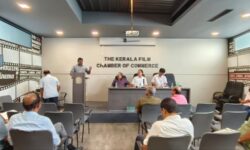KOCHI:
In peak summer, they took in the heat of virtually traversing every nook and corner of the venues for the country’s upcoming mega contemporary art festival. Six months down the line, when the fourth edition of the Kochi-Muziris Biennale (KMB) began in Kerala, each of its 90-odd installations was well in place for the viewer.
Meet the two curatorial assistants and others from the production wing of the ongoing event in Kochi to get a peek at stories from the biennale’s backstage. A team, whose key task was to arrange the exhibits in the space allotted to them. All of it depending on a range of factors around logistics, what with a sizeable number of works coming in from other countries and continents.
If the ongoing KMB 2018 has eminent artist Anita Dube as its curator, she had found critical hands-on support from her assistants Anushka Rajendran and John Xaviers. The duo began their assignment in May last year from Dube’s studio in the national capital, and went on to receive crucial back-up from the rest of the members in the production team. ‘Challenging’ and ‘educative’ are the two highlights of their key role in the presentation of the artworks at the 108-day biennale, billed as the subcontinent’s biggest of its kind.
Dube, 60, salutes the support she got from the production team and curatorial assistants in the task. “Each one of them ensured they understand the artists’ requirement. To achieve the desired result was topmost in their minds,” she says, thanking the members.
As for the curatorial assistants, Anushka and John worked closely with Dube in not just the travel and placement of the exhibits, but in finalising the artists as well. “We used to work at her Delhi studio with big layouts of each venue. The chief drill was to plan which artist will be slotted where — going by her curatorial note,” rewinds Anushka, completing her PhD in visual studies at the School of Arts and Aesthetics of Delhi’s Jawaharlal Nehru University (JNU). “It was no way easy. More so, initially, you have not seen all the venues and were just working on maps.”
Even to Fort Kochi’s Aspinwall House, invariably the biggest venue of the festival, it was only by late September 2018 the team got access. The one-and-a-half-century-old sea-facing heritage property wakes up from slumber only towards the run-up of the once-in-two-years biennale and yet again goes into inactivity by when monsoons hit the peninsula by June the following year.
It’s another matter that start of their assignment “way early” doesn’t necessarily help much in finishing the task better. “There will be these last-minute shuffling, alterations…” points out John, who holds a doctorate from JNU in cultural politics. “In fact, we did go for many changes once we got access to the venues. After all, things depend a lot on infrastructural requirements.”
For instance, the original idea was to place all the big art installations in TKM Warehouse at Mattancherry, another heritage town adjacent to Fort Kochi. “On visiting the site, we understood the practical difficulties,” reveals John. “Soon we chose to move the works to other venues.”
The current biennale features work by no less than 100 artists. “So it’s not easy when you are a team of just two coordinating with, say, 50 artists each,” points out John.
Predictably, there was a slew of emails, skype chats and constant WhatsApp conversations between the curatorial team and the artists. The host team had to understand well the requirements of the artists and make prompt arrangements. Looking back, Anushka comes with a comment that has a streak of black humour: “One of my biggest lessons in this project is that the most difficult project is the one that can be implemented easily. For, you have anticipated all the difficulties beforehand.” With a smirk, she adds: “It is the simpler works that cause hiccups.”
Substantiating, she speaks about South African Sue Williamson’s work, which has now turned out to be a big hit among the visitors at Aspinwall. “We knew she was going to recreate her older works for our biennale with new data and information. The work (‘One Hundred and Nineteen Deeds of Sale’) required over 2,000 identical bottles with a specific style of engraving. We were told of it in advance, so it all went off well.”
Similarly, Australian artist Brook Andrew had recreated one of his earlier works, this time taking references from Kerala and its history. “Initially, we were planning to showcase one of his large-scale installations. But the space allotted was insufficient, so he suggested recreating the work,” says Anushka. “That ensued a long chain of conversations. Brook suggested his work will have references of Kerala, thus needing cloth texts in two languages. Malayalam and Wiradjuri, symbolising the life of lands prior to colonial constructions.”
Adding to her point, Pavneet Pal Singh, coordinator – exhibition design & production, states the team has been “lucky” in some works too. South African William Kentridge’s video work required a space which was like a black room. But the space allotted to him, has natural light seeping in from the roof in different angle. “We were a little apprehensive in the beginning because covering the roof would have meant the budget going haywire. But, it worked in our advantage because Kentridge’s production team loved the locale, stating the natural light was acting as an element for the work.”
Installing EB Itso’s work featuring a huge rubber tyre was also a challenge, notes Pavneet. “Anita wanted the work to be installed in a closed space. Initially, we were planning to install it in Anand Warehouse. But the weight of the tire was posing a problem,” he explains. “We thought of cutting it into two and reinstalling it at the site. Even that didn’t become feasible. Finally, we chose to create a temporary enclosure at Aspinwall.”
Into the opening week of the biennale that began on December 12, the team faced challenges while installing some of the video works. “There were some technical difficulties we never anticipated,” says John. This, after a phase in August-September, when floods and landslides across Kerala had cast doubts on even whether the fourth edition of the biennale would happen in 2018, he adds.
The monsoon catastrophe had a telling effect on the biennale ideas of some installations. For, a few artists chose to change their work in a way that lent focus on the biggest Kerala calamity in a century. Bangladeshi artist Marzia Farhana’s work, for instance, ended up as a reflection of what she saw when she came to Kochi, points out Anushka. Adds John: “Jun Nguyen Hatsushiba’s was earlier just a video installation. Later a water element was added to it. That’s how people now walk into the waters to view the work.”
Jith Joseph A, Operations Assistant who worked closely with Marzia at the biennale, states the work was “therapeutic” for him, having affected by the flood. “It made me realise that every now and then, life will put you in front of a challenge and one need to rise up,” he adds.
Production manager Anil Xavier and coordinator Jayesh L R it gives them great satisfaction when the common people come and enjoy the works installed by them. “We happy to reach out to our audiences,” says Anil. Adds Jayesh: “It touches their life in a broader spectrum.”
Anushka and John say that, for all the challenges the team faced, it’s joy to see people flocking around the works.




